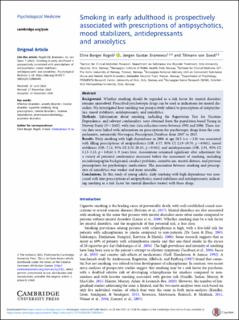Smoking in early adulthood is prospectively associated with prescriptions of antipsychotics, mood stabilizers, antidepressantsand anxiolytics
Peer reviewed, Journal article
Published version
Permanent lenke
https://hdl.handle.net/11250/3024962Utgivelsesdato
2021Metadata
Vis full innførselSamlinger
- Artikler [5061]
- Publikasjoner fra CRIStin FHI [7536]
Sammendrag
Background. Whether smoking should be regarded as a risk factor for mental disorders remains unresolved. Prescribed psychotropic drugs can be used as indications for mental disorders. We investigated how smoking was prospectively related to prescription of antipsychotics, mood stabilizers, antidepressants, and anxiolytics. Methods. Information about smoking, including the Fagerström Test for Nicotine Dependence, and relevant confounders, were obtained from the population-based Young in Norway Study (N = 2602), with four data collection waves between 1992 and 2006. These survey data were linked with information on prescriptions for psychotropic drugs from the comprehensive, nationwide Norwegian Prescription Database from 2007 to 2015. Results. Daily smoking with high dependence in 2006 at age 28.5 (S.D. = 2.0) was associated with filling prescriptions of antipsychotics (OR, 6.57, 95% CI 2.19–19.70, p = 0.001), mood stabilizers (OR, 7.11, 95% CI 2.51–20.15, p < 0.001) and antidepressants (OR, 1.91, 95% CI 1.13–3.23, p = 0.016) 1–9 years later. Associations remained significant after adjustment for a variety of potential confounders measured before the assessment of smoking, including sociodemographic background, conduct problems, cannabis use, mental distress, and previous prescriptions for psychotropic medications. The association between smoking and prescription of anxiolytics was weaker and more unstable. Conclusions. In this study of young adults, daily smoking with high dependence was associated with later prescriptions of antipsychotics, mood stabilizers and antidepressants, indicating smoking as a risk factor for mental disorders treated with these drugs. Introduction
